If you live in a very cold climate, your horse or pony may benefit from wearing a turnout blanket when he’s outside in the elements. Turnout blankets are waterproof blankets that usually have a tough nylon or polyester shell (the outside part) to protect your horse from wind, rain and snow and a layer of poly fill insulation (the inside part) to keep your horse warm in chilly conditions.
You can buy turnout blankets at the local tack shop or order one from a catalog or Web site. It’s important to know what size to buy your horse, because a well-fitting blanket is a must. If a blanket doesn’t fit properly, it won’t protect your horse properly and it may cause nasty rubs that will make your horse look scruffy.
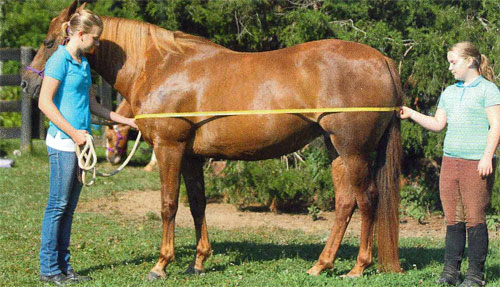
Measuring your horse
Blankets tend to come in two inch increments, starting at 72 inches (pony-sized) and going to 84 inches (big horse-sized). To find out what size your horse needs, ask a friend to help measure him. Place a cloth tape measure in the middle of his chest, as shown, and then roll it out to the middle of his tail. This should give you a good idea about what size your horse needs.
Fitting a blanket
When trying a new blanket on your horse for the first, time, put a lightweight sheet on underneath so you don’t get the new blanket dirty. If it doesn’t fit, you’ll have to return it and if it’s muddy, the store may not take it back.
Putting on a blanket
If your horse has never worn a blanket before, let her smell it and rub it gently on her back and shoulders. Some horses think brand-new blankets can be scary!
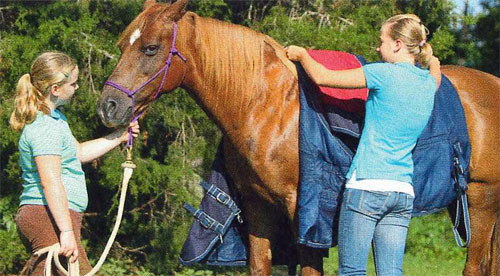
Fold the blanket in half has shown and slip it over your horse’s neck. Then move it back slowly until it sits right over the withers.
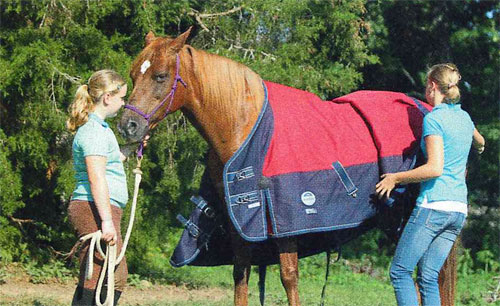
Then unfold the back part of the blanket and rest it on your horse’s hind quarters.
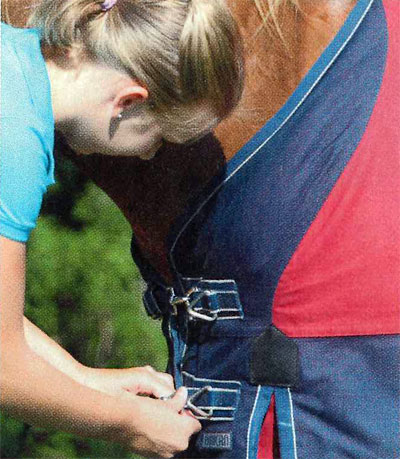
Always start at the front of your horse when fastening the blanket straps. Fasten the chest straps first.
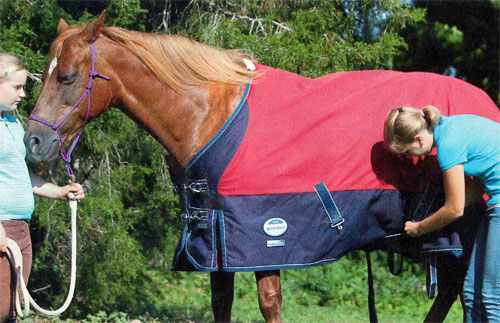
Next, move on to the belly straps. The chest straps should be secure, but not tight. Same goes for the belly straps. You don’t want them loopy because your horse could get a leg caught in them. You should be able to move your flat hand around easily between the strap and your horse’s belly.
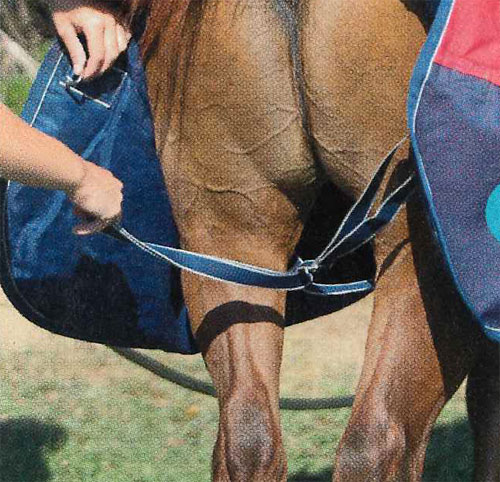
If there are leg straps, fasten the right strap to the right D-ring and then take the left strap, weave it through the right strap and then fasten it to the left D-ring. Securing the straps like this prevents them from rubbing the inside of the legs.
Make sure the belly straps and the leg straps are even. One strap shouldn’t be loopy and the other strap tight. Keeping them even helps to keep the blanket balanced correctly on your horse. You don’t want to find him walking around his field with his blanket dragging below his belly in the mud!
Does the blanket fit?
You should be able to run your hands all around the blanket’s neckline. If you can’t squeeze your hand in, the blanket is too tight or too small.
The blanket should cover and protect your horse’s tail. You don’t want rain or snow sneaking in the back end.
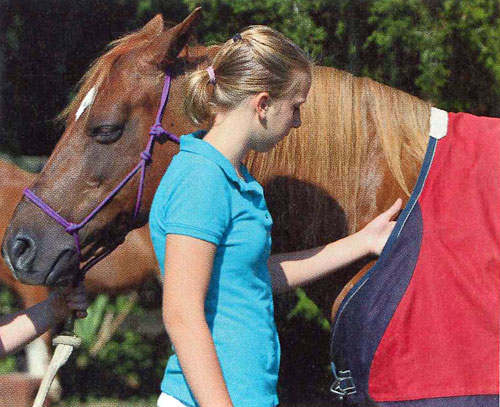
Watch your horse walk in the blanket. Is the fabric straining over his shoulder area? If the blanket is too tight in this area, it could rub the hair on the shoulder, leaving ugly bald patches. Some blankets have shoulder gussets that alleviate shoulder pressure and allow more freedom of movement.
If your horse seems to get shoulder rubs no matter what kind of blanket he’s wearing, invest in a stretchy shoulder guard made of nylon and spandex that he can wear underneath his turnout blanket. There are also quilted shoulder guards.
Taking off the blanket
Taking off a blanket sounds pretty easy, but plenty of people forget to undo the leg straps and end up with a spooked horse galloping off with a blanket dragging behind him! Don’t make this mistake.
Start by unfastening the legs straps, and then move to the belly straps. Unfasten the chest straps last. Fold the front of the blanket over the back of the blanket and slide it over your horse’s hindquarters.
Storing a blanket
When you take off a blanket, are you guilty of tossing into a crumpled pile on the barn floor and forgetting about it? Blankets can be expensive and they will last longer if you look after them properly. Hang up a wet blanket and allow it to dry before putting it back on your horse. It’s a good idea to have two blankets per horse, so you can replace a wet blanket with a dry one.
At the end of the winter, wash the blanket yourself with a hose and gentle detergent and let it dry. Treat the blanket with a waterproofing solution if necessary.
If you don’t want to wash the blankets yourself, ask a local tack shop employee to recommend a person who cleans horse blankets.
If the blanket has rips or holes, get them repaired. Once again, the handy tack shop employee should know someone who does blanket repair.
Once you get the blanket back, fold it up neatly and store it in a container where it will stay dry—and away from mice that might chew holes in it.
All of this might sound like a lot of work, but you’ll be glad you did it when it begins getting cold in the fall and you need to blanket your horse again.
This article originally appeared in the November/December issue of Young Rider. Click here to subscribe!






